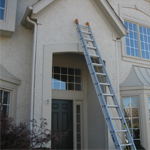By Safe Electricity
SPRINGFIELD, Ill. – Ladders are tools that allow homeowners and construction workers to climb up closer to important tasks that they need to work on, but they can also put people dangerously close to overhead power lines. Knowing where power lines and other potential hazards are should be part of the planning process for any outdoor project involving ladders. Whether it is trimming trees, cleaning gutters, or repairing a roof, Safe Electricity provides tips to help all those using ladders to do so safely.
“Knowing what is overhead and what is over your head could save your life,” says Molly Hall, executive director of the Energy Education Council and its Safe Electricity program.

According to the Occupational Safety & Health Administration, of the more than 4,000 worker fatalities in private industry in 2014, one in five worker deaths were in construction. The top causes of these tragedies are called the “Fatal Four,” which are falls, electrocutions, struck by object, and caught-in/between. When working with ladders, falling is the top safety concern, and contact with overhead power lines presents the second highest risk.
In August 2016, the Dayton Daily News in Ohio reported on an incident in which two people replacing a roof on a church each received a serious electrical shock while in the process of relocating a ladder. Also in August, NBC 2 out of Fort Myers, Fla. reported that a 20-year-old man lost his life when he and a co-worker accidentally leaned their ladder against overhead power lines.
“It can be very easy to overlook electric lines that connect homes and businesses to the power grid. We see them every day, and they can blend into the background, especially when engrossed in a project,” explains Hall. “That is why it is so important, before tackling any outdoor project, to take a few minutes to prepare to do the job safely.”
Safe Electricity shares the following ladder safety tips:
- Always look up and look out for overhead power lines or equipment.
- Keep yourself and ladders far away – at least 10 feet in all directions, at all times – from power lines, including service lines.
- Carry ladders horizontally.
- Make sure that the area above the ladder is clear before placing it upright.
- Long ladders may be unwieldy, so ask for help in carrying and setting them up.
- Always make sure that the ladder is on a solid, level surface before attempting to climb.
- Inspect the ladder before and after use to make sure that there is no damage that could put users in danger.
“It’s also important for homeowners to recognize that some projects may be beyond their expertise,” adds Hall. “Be willing to hire a professional for projects that involve work close to electrical equipment.”
–
The Energy Education Council is a 501(c 3 non-profit organization dedicated to promoting electrical safety and energy efficiency. Established in 1952, the Council is headquartered within University of Illinois Extension and serves as a forum for diverse utility and energy organizations to collaborate on the mutually vital issues of efficiency and safety.
–
Comments welcome.
Posted on October 17, 2016


